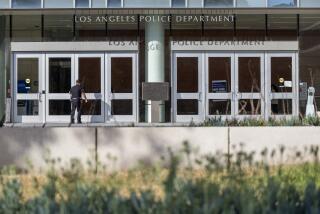Police Deployment Formula Must Address Racial Imbalances
- Share via
For many years black community organizations have complained about discrimination in the deployment of police officers in Los Angeles. These groups and their leaders repeatedly have pointed to statistics documenting that predominantly black areas of the city have the worst police protection. The cries for reform have been ignored, even amid escalating gang violence in South-Central Los Angeles.
A few weeks ago the Los Angeles Police Department received a report from outside consultants who had been commissioned to study the problem. No matter what Police Chief Daryl F. Gates and the consultants say, statistics in the detailed report confirm what was suspected all along: There is systematic and unconscionable racial discrimination in the assignment of Los Angeles police officers.
For example, the study describes the importance of “pro-active” or discretionary patrol time--the time when uniformed officers cruise the neighborhoods, not already answering specific calls but alert and available. Of 18 LAPD divisions, the three with the highest percentage of available patrol time are the three with the highest percentages of white residents. In those divisions officers spend half their time watching for trouble before it happens. In shameful contrast, in the two divisions with the smallest percentage of white residents, Newton and 77th, inadequate deployment leaves officers rushing from crime report to crime report with only about a fifth of their time available for patrol. That leaves the people of crime-ridden Newton and 77th with far less than the 40% discretionary patrol time recommended in the report for all neighborhoods in Los Angeles.
This pattern is not simply a random coincidence. A substantial number of officers are assigned according to a formula that obviously disadvantages the areas that most need police protection. For instance, the formula considers the amount of reported crime in an area, but weighs crimes against the person and crimes against property in exactly the same manner. This is not only an incorrect value choice because stopping violent crimes must be the city’s highest priority; it also ignores the fact that it takes much longer for officers to investigate crimes against the person. Hence the formula’s equating of property and personal crimes disadvantages areas that have more violent crimes. Also, in allocating officers the long-established formula does not even consider the amount of time during which officers are unavailable in each division or the average response time in answering calls.
Gates said after the study was released that he had devised a new formula for deploying officers. This is a positive step, but it is strange that he refuses to let anyone know the formula or how it is a modification from earlier practices. The people of Los Angeles should demand that he release the new formula immediately for study and evaluation. The people of Los Angeles must loudly and repeatedly insist that discrimination in the allocation of city services, especially for something as vital as police protection, will not be tolerated. Inaction in itself reflects the city’s not-at-all-benign neglect of South Los Angeles’ need for greater protection from violent crimes.
Adequate police protection is not a luxury. A fast response from the police might scare off a culprit before a crime--or at least facilitate apprehension. It is unconscionable that the availability of police officers and the quality of protection depend so heavily on the race of the people in your neighborhood. The discrimination also is unconstitutional; it is a denial of the assurance of equal protection of the laws guaranteed in the constitutions of the United States and the state of California.
Without a doubt all areas of the city can use more police services. The consultants’ report details many ways in which the productivity of the Los Angeles Police Department can be enhanced. The study also strongly recommends the hiring of additional officers. But the report is unequivocal that when those officers are deployed they must be allocated in a way that compensates for current imbalances. Maximizing police efficiency, as the recent study recommends, and hiring additional officers should make it possible to increase protection in South Los Angeles without shortchanging any part of the city.
More to Read
Sign up for Essential California
The most important California stories and recommendations in your inbox every morning.
You may occasionally receive promotional content from the Los Angeles Times.










